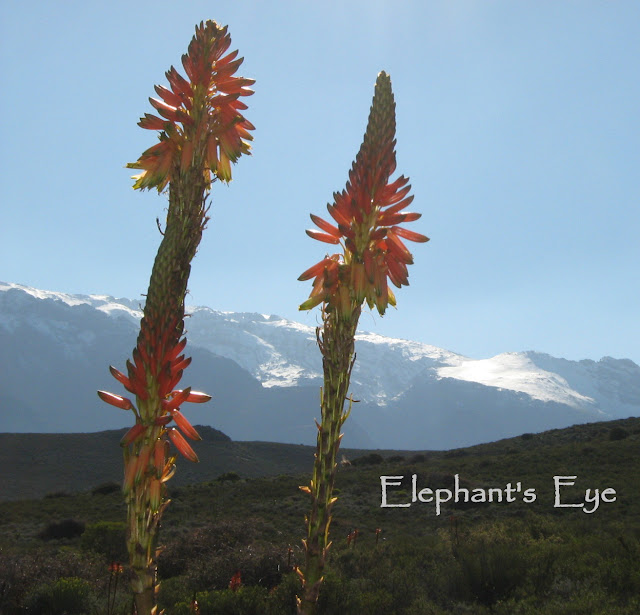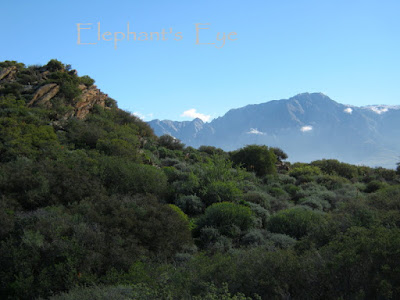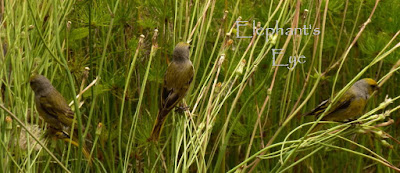Karoo aloes with snow and Cape canaries
by Diana
Studer
- gardening for biodiversity
in Cape Town, South Africa
Winter magic in the Western Cape is flaming spires of aloe
against snowcapped mountains. We visited the the Karoo
Desert National Botanical Garden when we lived in Porterville. About 100
kilometres from us inland to Worcester, tucked between the Western Cape
mountains. Still within the winter rainfall mediterranean climate, but drier
and hotter / colder than fynbos or renosterveld. These succulents
are dormant in the long hot summer, and happily flower in winter rain.
December 2011 Veld
& Flora has an article by Werner Voigt on the history of the Karoo NBG.
The garden was established in 1921. In 1945 Swiss curator Jacques
Thudichum worked with Louis Pieterse to move the plant collection from near
Matjiesfontein to Worcester. The garden was opened in 1948 when Jan Smuts said
– ‘The human spirit craves for something
more. It requires spiritual nourishment and here it is in the Karoo Garden.’
In 2001 the word Desert was added to
the formal name, to explain the word Karoo
(place of great thirst) to international visitors.
Lime green flowers on Euphorbia mauritanica were lit up in Worcester, back home
in our garden there is promise in the burgeoning leaf tips, but not even buds
yet. In a spoonful of rock chips a shell-pink Oxalis found a tiny home.
Large luminous apple-green leaves on the botterboom, Tylecodon
paniculatus. I have a tiny
plant in our garden now and the snails devour the leaves almost as fast as they
grow!! I am scattering wood ash around the plant to deter them.
The Worcester aloes flowers shade from olive green thru
buttery yellows to a subtle orange. July 2010 to the aloes
and November 2010 to the birds
of the Karoo.
Cape canaries on hawkweed
in our Porterville garden January 2012
Take time to look. Give yourself a chance to see the
wildlife that is in your garden. Stop and smell the roses. I took a photo of a
rose, walked past a few minutes later, and thought, what’s that green smudge on
my photo? A preying mantis was halfway thru eating a honey bee. Later still,
just the discarded ‘bones’. --- If I don’t look, is there biodiversity? (Yes,
but, I won’t notice it).
When I glanced out of the Porterville laundry window, I saw
an entire flock, a horde, of Cape canaries Serinus
canicollis. Busily harvesting the puffballs on the hawkweed!
Hawkweed is closely related to dandelions. Worldwide there are thousands of species of Hieracium. The buttery yellow
fringed delight of the petals has faded into the bee’s
memory of November. I had been planning to cut back the effusive bunches of
dead flower stems. The birds made me grateful I hadn't got around to it.
Hawkweed is seen simply as a weed. Ours certainly planted
itself and was happy with our climate and soil. Garden-worthy flowers for me
and food for the bees. Seeds for the Cape canary. I need to look out for
hawkweed in our False Bay garden.
I invite you to join us at Elephant's Eye on False Bay.
Please subscribe as you prefer
via Feedly,
or Bloglovin,
Teal blue text is my links.
To read comments if you are in email or a Reader,
first click
thru to the blog)
Thanks for comments that add value. Maybe start a new thread
of discussion? BTW your comment won't appear until I've read it. No Google
account? Just use Anonymous, but do leave a link to your own blog. I would
return the visit, if I could ...
I welcome comments on posts from the last 2 months.
Danke für sinnvolle Kommentare. Die werden erst veröffentlicht nachdem ich sie gelesen habe. Es können auch Bemerkungen sein die in eine ganz andere Richtung gehen.
I welcome comments on posts from the last 2 months.
Danke für sinnvolle Kommentare. Die werden erst veröffentlicht nachdem ich sie gelesen habe. Es können auch Bemerkungen sein die in eine ganz andere Richtung gehen.










We had a beautiful Aloe that stunned us when it bloomed - we never quite knew what it was, only that it was beautiful and we thought it quite unique since we've not seen a plant like this in the area where we lived. This was 10 years ago, and when we moved I realised that actually, it is quite popular in the gardens outside of the previously disadvantaged communities. Thanks for the memory.
ReplyDeleteIt is dramatic and exciting when aloes burst into bloom. Never get tired of seeing that!
DeleteLOVED the photos of the cape canaries. Taking time to truly see and appreciate gardens, wild or private, and its resident wildlife is an important message. I have to remind myself sometimes that capturing photos is not the purpose of a garden stroll.
ReplyDeletePhoto ... laptop ... try again. Drives me mad sometimes. We have sunbirds on the red Lachenalia just thru the window, but the glare from the sun offends my camera. Won't!
DeleteI enjoyed every bit of your interesting post, the winter light is superb ... Especially in your first photo, the Aloe is stunning against the snow capped mountains. 155 species of Aloe in this region is amazing. Lovely photos, what camera are you using?
ReplyDeleteThese are archived photos and both of those cameras have died. But I do have a new Canon that I am still learning to use.
DeleteIt's so wild to think that you are in the middle of winter--and your landscape is so lush and green! I can't imagine how nice it would be to have growing things going strong in all the seasons! We have Hawkweed here, too--the yellow and the orange ones. :)
ReplyDeleteOrange hawkweed - now that, is beautiful!
Deletehttps://plantpostings.blogspot.co.za/2013/06/wildflower-wednesday-chance-encounters.html
I'm surprised you have snails - does that mean you've had rain? We used to have lots and years ago on wet nights I'd go round stomping on them, but now I only see the occasional one. The aloes look lovely against the dramatic background and that closeup photo of the canary is fantastic.
ReplyDeleteBetween the mulch and the succulents the snails lurk and wait for lunch. I miss the hadeda who used to come each day and work around the garden. Tonite we expect serious rain!
DeleteI had to google hadeda - it's an ibis. Enjoy the rain.
DeleteI hope you get a good amount of rain! Enjoyed your Aloe post in the KDNBG. The landscape looks very like what is known as the "coastal sage scrub" plant kingdoms in Southern California (nearly wiped out now by humans). Very informative and interesting posts. Now I know what "karoo" means.
ReplyDeleteIn my garden is lots of Gaillardia, which looks and bloom better dead-headed, but I leave a few seed heads always so the Lesser Goldfinch has food (they seem to love the Gaillardia seeds). The plants are only part of the equation; the local birds, lizards, even rodents are a part of the whole.
Karoo bossies (little shrubs) include various sages and wild rosemary.
DeleteThere are rare proteas which carry their flowers close to ground - and are pollinated by mice.
Great photos of the Cape Canaries! You are so right about taking time to see the wildlife in the garden. How often I have noticed something on a photo once it is blown up on the computer screen, but I had totally overlooked it in the garden. It is always a pleasure when i do catch sight of little critters in the garden. The other day I saw a handful of newborn grasshoppers; I am not sure I was happy to see them. Hopefully, hungry birds saw them, too!
ReplyDeleteDespite bitterly cold (for Cape Town) there are lots of caterpillars wandering our garden.
DeleteLike Catmint, I was surprised you have snails. Does the wood ash deter them? I have my own theory about snails. I think that once they smell something they like, nothing will stop them from getting there. The only option is to hide the tiny plant amongst stronger smelling plants or to smother it in garlic :-) I like that Worcester aloe... beautiful yellow color!
ReplyDeleteWe do have gazillions of snails. They tuck themselves away in their shells and wait for rain ... then out they come. (My mother used to call the tiny baby snails 'garlic snails')
DeleteI read about wood ash, and thought why not try? We have a wood stove and I distribute the ash around bulbs and the snail's favourite - seems to help a bit.
The Cape canaries are so sweet. I've been chasing hummingbirds all day trying to capture a picture -- with no luck. Just have to sit quietly and enjoy them. P. x
ReplyDeleteI've tried thru the window here, but no joy.
DeleteYour photograph of the aloes against the snow-capped mountains is special. I'm glad to know I'm not the only one who has spent a great deal of time unsuccessfully trying to photograph birds (like Pam, hummingbirds). A European species of hawkweed is a very common weed, here; I find it very cheerful.
ReplyDeleteAgain, my husband takes credit for that aloe and snow photo (on the older better departed camera ;~(
DeleteGreat contrast of snow and aloes in bloom. That Karoo...seems like the kind of place I need to visit.
ReplyDeleteWith your desert eye, you would enjoy it. The Great Karoo is semi-desert and wide open spaces. The Little Karoo shares our mediterranean winter rainfall. Giving us a wide spectrum of succulent plants.
Delete